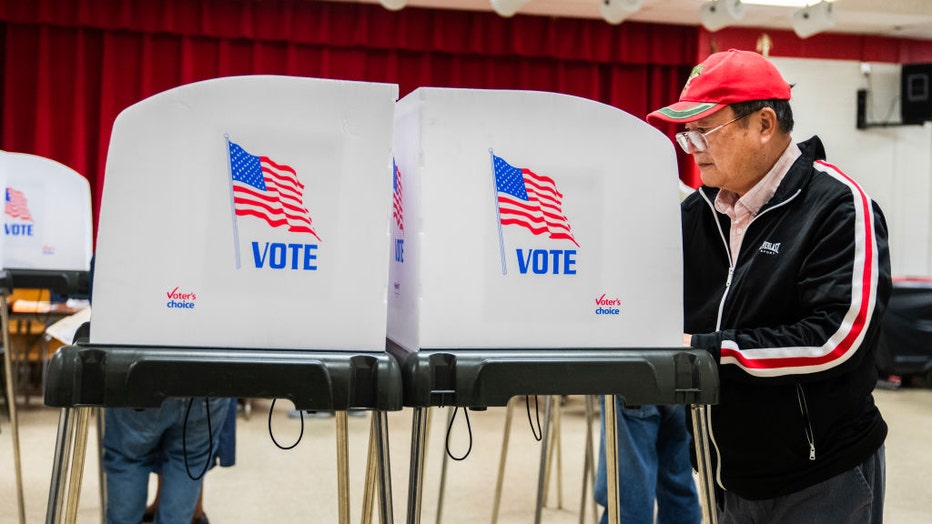Swing states: Trump wins Wisconsin, Pennsylvania, North Carolina and Georgia
Election 2024: Swing state showdown arrives
As Americans head to the polls in one of the most anticipated elections in modern history, Battleground brings you real-time coverage from crucial swing states that could determine the outcome. Host S.E. Cupp connects with reporters on the ground for live updates on voter turnout, polling place operations, and early insights from Nevada to Pennsylvania. Battleground provides essential coverage of the race to 270 as America makes its choice.
Former President Donald Trump has inched closer to the White House with 267 electoral votes, after winning Pennsylvania, according to FOX News as of 1:24 a.m.
After Trump's key battleground win of Pennsylvania, he followed that with Wisconsin, which was called for him by FOX News at 1:50 a.m.
The win gives Trump 277 electoral votes with Pennsylvania's 19 and Wisconsin's 10 votes.
Trump's Wisconsin win with 51.3 percent of the vote with 88 percent of all ballots in, capped a night that included four battleground wins and leads in two others including Michigan.
RELATED: Roughly 82 million voted early in the 2024 election – here are some takeaways
From early voting to extended mail-in deadlines, each state has its own approach that could shape the timeline for Tuesday night. Here’s a quick look at when we’re likely to know who won in battlegrounds like Michigan, Pennsylvania, and Georgia.
Pollsters keep an eye on Election Day
Dr. Andy Smith from the University of New Hampshire Survey Center joins LiveNOW from FOX on Election Day with tips for deciphering the math behind the polls and how to better understand them.
Michigan: First presidential election with early voting
Michigan's 2024 election will be the first time the state offers early voting during a presidential election, which officials hope will ease lines on Election Day.
Here are some key factors for the state to consider:
- Voting options: Absentee ballots were mailed out starting Sept. 26, with in-person early voting beginning Oct. 7.
- Counting timeline: Clerks are allowed to begin processing absentee ballots eight days before Election Day, which could reduce delays. Many counties expect to have 90% of absentee ballots processed before polls open.
- Potential delays: Some clerks are concerned about USPS delays, which could impact ballots mailed close to Election Day. Voters are encouraged to submit absentee ballots at least two weeks early.
With a high turnout expected, Michigan election officials aim to avoid the delays seen in 2020 by utilizing early voting and efficient absentee processing.
North Carolina: 90% of votes expected by midnight
North Carolina aims to report nearly all (90%) of its votes by midnight on Election Day, Nov. 5. Details include:
- Absentee ballots: The state processes absentee ballots weekly beginning Oct. 1, allowing them to be counted immediately once polls close.
- Early voting: In-person early voting is available from Oct. 17 through Nov. 2, and totals are processed before Election Day.
- Weather challenges: Western North Carolina faces potential complications from Hurricane Helene’s aftermath, which affected polling site accessibility. New rules provide more options for impacted voters.
Given the streamlined processes, North Carolina is likely to have results earlier than many other swing states.
Around 11:21 p.m., the Associated Press declared the North Carolina race for Trump.

FOX News has called Pennsylvania for Donald Trump, taking 19 key electoral votes, leaving Harris with almost no route to win.
Trump has been projected to take the Keystone State with 51.2 percent of the vote to Harris' 47.8 percent with 91 percent reporting.
In Pennsylvania, mail-in ballots cannot be processed until 7 a.m. on Election Day, leading to expected delays in results. Key details include:

- Mail-in voting: Over 1 million people used mail-in ballots in the last governor’s election. This year, a new bill allowing pre-Election Day processing remains stalled in the state legislature.
- Counting timeline: Without early processing, mail-in ballots may take days to count, especially in a close race. Democrats tend to favor mail-in voting, so early results may lean Republican until mail ballots are processed.
- Legal and legislative factors: Former Gov. Tom Wolf’s Act 77 expanded mail-in voting, and ongoing political tensions impact any attempts to change Pennsylvania’s counting procedures.
Pennsylvania’s Secretary of State has indicated that voters shouldn’t expect a clear winner on election night, especially given the anticipated high mail-in turnout.
Nevada: Extended counting due to mail-in ballots
Nevada allows mail-in ballots postmarked by Election Day to be counted up to four days after, which may delay final results:
- Mail-in voting: With more than half the state voting by mail, ballots postmarked by Election Day are accepted for counting until four days afterward.
- Upgrades: A new statewide registration system is designed to speed up counting, with Clark County adding tabulation equipment to manage high turnout.
- Counting timeline: Results may be available gradually, but a definitive outcome could take days, particularly in close races.
In 2020, Nevada’s results were confirmed four days after Election Day, and 2024 may follow a similar timeline.
Arizona: High early ballot drop-offs on Election Day
Arizona’s high volume of early ballots dropped off on Election Day itself has historically delayed final results:
- Ballot verification: Early ballots dropped off on Election Day undergo verification, including signature checks, before being counted. Maricopa County, in particular, saw a record 100,000 ballots dropped off on Election Day in 2020.
- Counting timeline: As of Nov. 10 in the 2020 election, 619,000 ballots were still uncounted. This trend could repeat in 2024 due to tight races and record turnout.
- Comparison with Florida: Unlike Arizona, Florida only allows Election Day drop-offs at county election offices, which may explain its faster reporting.
Officials in Arizona expect a close race, with results likely unfolding over days as late ballots are verified and counted.
Wisconsin: Absentee ballots and tight races delay results
Trump was projected to win Wisconsin's 10 electoral votes with 51. 3 percent of the vote. The win secured 10 Electoral Votes which pushed him over 270 threshold.

Wisconsin expects delays due to absentee ballot procedures and close races:
- Counting procedure: Wisconsin counts absentee ballots centrally in certain counties, which cannot begin until 7 a.m. on Election Day. Milwaukee’s results, for example, typically come in late at night or early the following morning.
- Political polarization: Close races require nearly all ballots to be counted before results are called, contributing to longer wait times for unofficial results.
- Historical timeline: In 2020, the AP called Wisconsin the day after the election. Based on past years, unofficial results for the 2024 election may not be available until early on Nov. 6.
Election officials emphasize accuracy over speed, with late-night absentee counts expected to affect early results.

FILE-A voter fills out a ballot at a voting poll during early voting. (Tom Williams/CQ-Roll Call, Inc via Getty Images)
Georgia: Legal challenges and record turnout
Georgia faces record turnout amid a high number of legal challenges that could impact vote processing:
- Litigation: Recent lawsuits challenge voter registration deadlines, candidate qualifications, and last-minute State Election Board rules. The Georgia Supreme Court recently delayed ruling on last-minute changes until after the election.
- Voter registration: Hurricane Helene led to lawsuits seeking to extend voter registration deadlines, though these were ultimately denied.
- Third-party candidates: Some ballots may include disqualified third-party candidates due to a Supreme Court ruling issued after absentee ballots were distributed.
With numerous lawsuits and high turnout, Georgia’s election results may be delayed, particularly in close races.
Around 12:45 a.m., FOX NEWS called the race for Trump.
The Source: This article compiles information from previous FOX TV Stations reporting and reports from The Associated Press. Key insights were gathered from interviews with local officials and information provided by state election boards.

